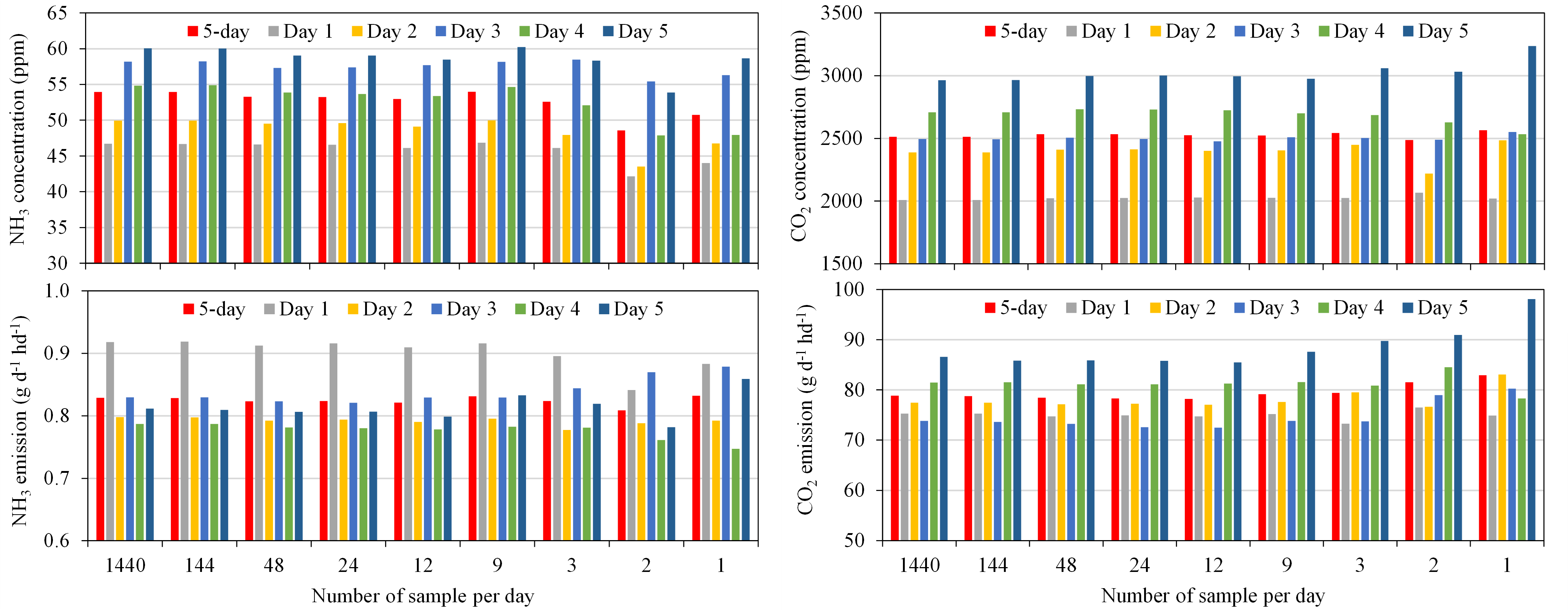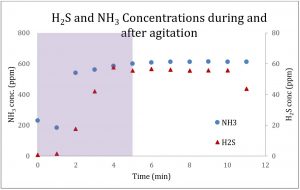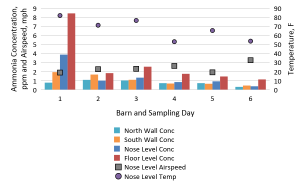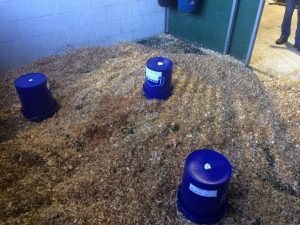Purpose
Alum has been successfully used in the poultry industry to lower ammonia (NH3) emission from the barns. However, it has not been evaluated to reduce NH3 on beef feedlot surfaces. Additionally, it is not known how it would affect other common emissions from beef feedlot surfaces. The purpose of this study was to determine the effect of adding aluminum sulfate to beef feedlot surfaces on NH3, hydrogen sulfide (H2S), carbon dioxide (CO2), methane (CH4), and nitrous oxide (N2O) emissions.
What Did We Do?
Eight feedlot pens (30 animals per pen) at the U.S. Meat Animal Research Center feedlot were utilized. The pens had a central mound constructed on manure and soil and 3 m concrete apron by the feed bunk and cattle were fed a corn-silage based diet. Four pens (30 cattle/pen) had 10% (g g-1) alum applied to the 6 meters immediately behind the concrete bunk apron and four did not receive alum. The amount of alum added to the area was determined on a mass basis for a depth of 5 cm of feedlot surface material (FSM) using the estimated density of feedlot surface material for Nebraska feedlots (1.5 g cm−3). On sampling days, six representative grab samples were collected from the feedlot surface from the six-meter area behind the bunk apron in each pen; samples were combined within pen to make three representative replicates per pen (N=24). Each of the three pooled samples per pen were measured for pH, NH3, H2S, CH4, CO2, and N2O using petri dishes and wind tunnels in an environmental chamber at an ambient temperature of 25°C (77°F) and 50% relative humidity. Flux measurements for NH3, H2S, CH4, CO2, and N2O flux were measured for 15 minutes using Thermo Fisher Scientific 17i, 450i, 55i, 410iQ, and 46i gas analysis instruments, respectively. Samples were analyzed at day -1, 0, 5, 7, 12, 14, 19, 21, and 26.
What Have We Learned?
Addition of alum lowered pH of FSM from 8.3 to 4.8 (p < 0.01) and the pH remained lower in alum-treated pens for 26 days (p < 0.01). Although the pH remained low, NH3 flux was only lower (p < 0.01) at day 0 and day 5 for alum-treated pens compared to the pens with no alum treatment. Nitrous oxide emission was not affected by alum treatment (6.2 vs 5.7 mg m-2 min-1, respectively for 0 and 10% alum treated pens). Carbon dioxide emission was lower for alum-treated pens than non-treated pens from day 5 until the end of the study (p < 0.05), perhaps due to suppressed microbial activity from the lower pH. Hydrogen sulfide emission was higher (p < 0.05) from alum-treated feedlot surface material (0.8 mg m-2 min-1) compared to non-treated feedlot surface material (0.3 mg m-2 min-1), likely due to addition of sulfate with alum. Methane emission was also higher in alum-treated pens (173.6 mg m-2 min-1) than non-treated pens (81.4 mg m-2 min-1). The limited reduction in NH3, along with increased H2S and CH4 emission from the FSM indicates that alum is not a suitable amendment to reduce emissions from beef feedlot surfaces.
| Table 1. pH, ammonia (NH3), hydrogen sulfide (H2S), methane (CH4), carbon dioxide (CO2) and nitrous oxide (N2O) emission from feedlot surface material treated with 0 or 10% alum (g g-1 mass basis). | ||||||||||||
| pH | NH3 (mg m-2 min-1) |
H2S (mg m-2 min-1) |
CH4 (mg m-2 min-1) |
CO2 (mg m-2 min-1) |
N2O (mg m-2 min-1) |
|||||||
| Day | 0% Alum | 10% Alum | 0% Alum | 10% Alum | 0% Alum | 10% Alum | 0% Alum | 10% Alum | 0% Alum | 10% Alum | 0% Alum | 10% Alum |
| -1 | 8.1 | 8.3 | 229.6d | 515.9c | 0.3 | 0.4 | 136.3 x | 73.4w | 4,542 | 3,234 | 3.1 | 4.2 |
| 0 | 8.3a | 4.8b | 163.0c | 32.4d | 0.2 f | 1.8 e | 43.1 x | 193.8w | 4,372 | 5,294 | 2.9 | 1.8 |
| 5 | 8.5a | 6.3b | 279.5c | 83.6d | 0.4 | 0.5 | 84.1 x | 309.5w | 404y | 1,347z | 6.0 | 6.8 |
| 7 | 8.6a | 6.7b | 120.2 | 130.0 | 0.6 f | 1.2e | 53.4 | 61.7 | 468 y | 1,903z | 15.3 | 10.9 |
| 12 | 8.6a | 7.2b | 418.0 | 320.3 | 0.3 | 0.3 | 104.5 | 145.7 | 3,742y | 1,939z | 3.3 | 8.0 |
| 14 | 8.9a | 7.6b | 229.0 | 145.5 | 0.2 | 0.4 | 25.4x | 180.7w | 4,203y | 2,018z | 11.5 | 9.3 |
| 19 | 8.6a | 7.5b | 228.0 | 225.1 | 0.1 f | 1.1e | 132.3x | 254.7w | 5,999y | 3,116z | 6.9 | 5.8 |
| 21 | 8.4a | 7.2b | 232.0 | 257.0 | 0.5 | 0.8 | 81.9x | 250.0w | 4,324y | 2,477z | 2.2 | 1.9 |
| 26 | 8.6a | 8.0b | 584.5c | 319.9d | 0.1f | 0.7e | 72.2 | 92.9 | 5,534y | 3,540z | 4.7 | 2.9 |
| Within a parameter and day, different superscripts indicate a significant difference (p < 0.05) between the emissions from the feedlot surface material treated with 0% and 10% alum. | ||||||||||||
Future Plans
Future research will evaluate the use of aluminum chloride instead of aluminum sulfate to lower pH of FSM and retain nitrogen. Additionally, microbial amendments are being evaluated to determine if they can reduce gaseous emissions from the feedlot surface.
Authors
Presenting author
Mindy J. Spiehs, Research Animal Scientists, USDA ARS Meat Animal Research Center
Corresponding author
Bryan L. Woodbury, Agricultural Engineer, USDA ARS Meat Animal Research Center
Corresponding author email address
bryan.woodbury@usda.gov
Additional Information
For additional information about the use of alum as a feedlot surface amendment, readers are direct to the following: Effects of using aluminum sulfate (alum) as a surface amendment in beef cattle feedlots on ammonia and sulfide emissions. 2022. Sustainability 14(4): 1984 – 2004. https://doi.org/10.3390/su14041984
Acknowledgements
The authors wish to acknowledge USMARC technicians Alan Kruger and Jessie Clark for their assistance with data collection and analysis.
The authors are solely responsible for the content of these proceedings. The technical information does not necessarily reflect the official position of the sponsoring agencies or institutions represented by planning committee members, and inclusion and distribution herein does not constitute an endorsement of views expressed by the same. Printed materials included herein are not refereed publications. Citations should appear as follows. EXAMPLE: Authors. 2022. Title of presentation. Waste to Worth. Oregon, OH. April 18-22, 2022. URL of this page. Accessed on: today’s date.










